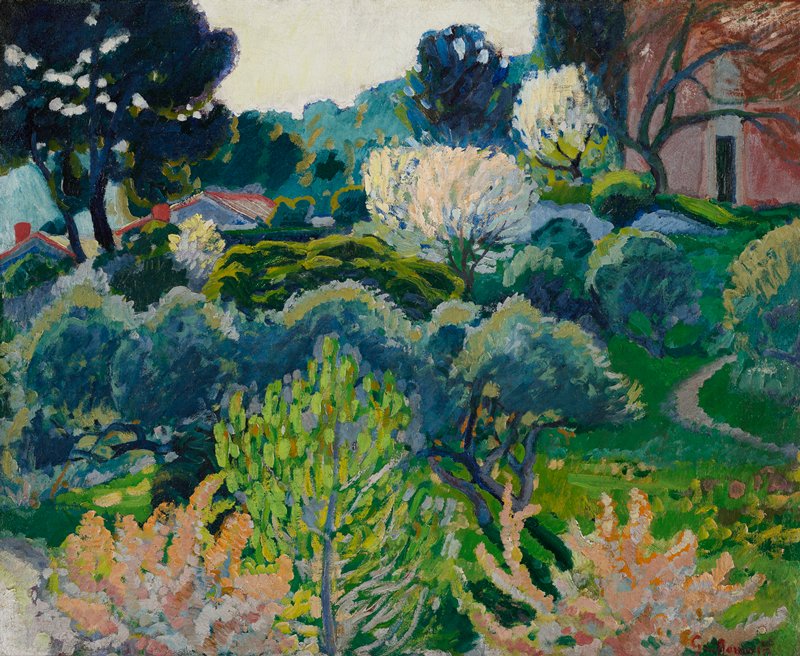This blog post was written by Pippa Potts is a co-convenor of the History of Gardens and Landscapes Seminar.
The idea had surfaced occasionally but, as so often, it took a nudge from elsewhere to make it a reality. The idea was that the excellent papers being given to the History of Gardens and Landscapes Seminar shouldn’t be allowed to vanish into thin air but be given a permanent and wider audience in a publication. The nudge came from the Birkbeck Garden History Group which had been responsible for publishing the work of students on the IHR’s MA garden and landscape history course until its demise in 2022. The group offered technical and financial support for a volume which would be self-published via Amazon. And so, at the end of August 2023 a paperback edition of Conversations in Garden History: New Research, New Ideas, New Approaches came out, with digital version following in April this year. Reviews have been uniformly positive.


Conversations in Garden History consists of a collection of papers, all of them from past speakers, some basing their contributions on their original presentations others taking a different tack. Where the word ‘Conversations’ comes in is in the pairing of essays, a dialogue between two different aspects of a particular theme. But there are other conversations going on too, some between geographic locations as far apart as Singapore and Detroit, Tenochtitlan and Aranjuez, others between periods such as the seventeenth and twenty first centuries. But perhaps the most important conversation is between the authors themselves in that they come from so many different walks of academic and professional life. Yes, there are garden historians, although their interests range widely from economics to social conditions, literature and politics. But there are others including specialists in Northern European manuscript illumination from the late medieval and Renaissance period and Spanish and American Indian Studies as well as a poet and writer whose work addresses issues of time, race, class and the environmental conditions underpinning Black identity. The range could have been wider still had it not been for space constraints, but even as it stands what is inescapable is that garden and landscape history cannot be narrowly defined, drawing from—and giving back to—a wide field of scholarship.
Conversations is a measure of the healthy state of garden and landscape studies, belied to considerable extent by the decline in the number of postgraduate courses on offer in the UK. It is also testimony to the work, applauded coincidentally by reviewers of the volume, done by the History of Gardens and Landscapes Seminar over the past twenty years. A quick look at the past themes and speakers is enough to bear this out. Seminar discussions have centred around issues such as women’s role in the garden, gardens created in wartime and gardens created in response to particular crises. How and why plants and garden styles have migrated around the world has been a topic with many different facets, sometimes overlapping with the enquiry into how politics and power play out in the creation, management and perception of gardens and landscapes. The most recent, 2023/24, programme was designed specifically to endorse the message of the Seminar’s publication that garden and landscape history is greatly enriched enriched by cross-disciplinary research. Presentations ranged from religion to the role of architects and looked at how geotechnical data and photography both give insights into the vision and intentions of a garden’s creator.
Some years ago four leading garden and landscape historians, writing in the prestigious US Studies in the History of Gardens and Designed Landscapes journal, asked the question ‘Whither Garden History?’. One of the authors called for garden making to be seen as ‘a product of a rich and intricate culture: political, economic and social’.[i] The History of Gardens and Landscapes Seminar can certainly be said to be responding to that challenge. For another of the writers the future of garden history was about ‘learning to recognize and interpret the ‘murky intertwining daily behaviours’ that constitute the landscapes of the past’.[ii] In tackling issues such as climate change, urban decay and the noxious aspects of colonialism the Seminar has helped move garden history on in that direction too.
With the publication of Conversations in Garden History, the rolling programmes of the seminar series, as well as the space given to work-in-progress every summer term, the History of Gardens and Landscapes Seminar is unique in providing a forum where new research being done in a multitude of different disciplines can be brought together and discussed. And, in doing so, it is constantly pushing the frontiers of knowledge outwards in a way that the contributors to ‘Whither Garden History?’ would have wished.
Pippa Potts is a co-convenor of the History of Gardens and Landscapes Seminar and editor of Conversations in Garden History: New Research, New Ideas, New Approaches.
Email: ihrgardenhistory@gmail.com
Twitter/X: @IHR_HistofGDLS
[i] John Dixon Hunt in Edward Harwood, Tom Williamson, Michael Leslie and John Dixon Hunt, ‘Whither Garden History?’, Studies in the History of Gardens and Designed Landscapes, Vol. 27:2, 2007, pp.91-112, p. 108
[ii] Mark Laird, ‘Whither Garden History?’, p. 107.
Banner image: By Armand Guillaumin – Minneapolis Institute of Art, Public Domain, https://commons.wikimedia.org/w/index.php?curid=118823539

